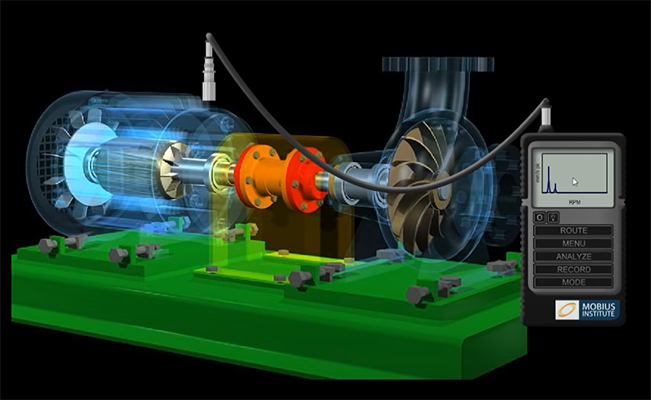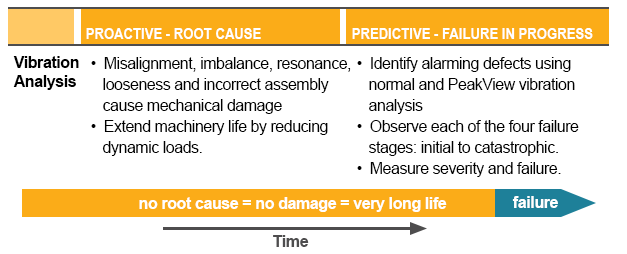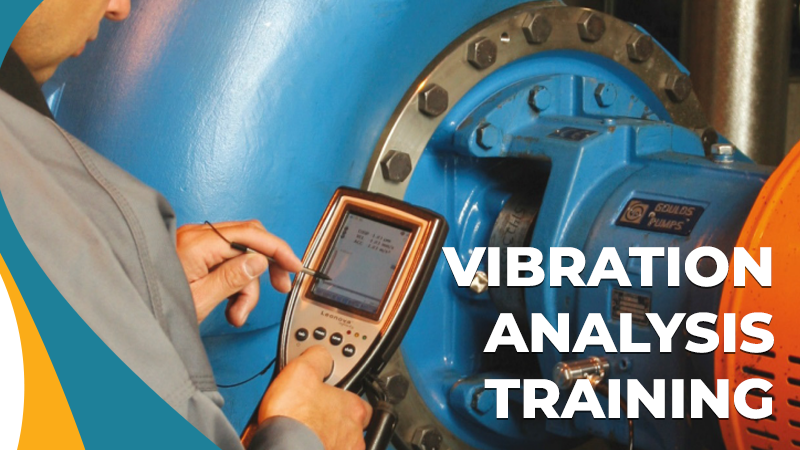Vibration analysis is one of the most popular and frequently utilized cbm technologies in various organizations. It is used for detecting patterns in vibration signals and monitoring their levels.
It is frequently carried out on both the time waveforms and the frequency spectrum of the vibration signal. Frequency analysis assesses the repeatability of vibration patterns by decomposing time waveforms. This enables quick and accurate frequency analysis as well as the creation of various digital noise filters.
 Photo by: Mobius Institute
Photo by: Mobius Institute
Measuring Vibration
Different types of sensors, such as piezoelectric (PZT) sensors or micro-electromechanical sensors, can be used to monitor vibration. For high-quality data to be captured, sensor placement is crucial. The preferred way for mounting sensors is to stud mount them on a clean, flat surface. This ensures the capturing of a broad and smooth frequency range.
Measurement of vibration acceleration in meters per second squared (m/s2) is required for a thorough assessment of vibration exposure. Direction and frequency of vibrations and the length of exposure are also determined. Because the quantity of vibrational energy entering the hands is affected by how strongly a person holds a tool, hand-grip force is another key consideration.
Fundamental Information About Vibration
Vibration is a physical phenomenon that occurs in operating spinning machines and moving structures, independent of their state of health. Vibrations can be caused by rotating shafts, meshing gear teeth, rolling bearing components, fluid fluxes, among other things. Vibration analysis is a very useful tool for determining the operating characteristics and state of rotating machinery and structures due to its widespread use. The displacement, velocity, and acceleration of vibrations can all be expressed in numerous ways.
What Vibration Analysis Detects
Acceptable operating vibration limits can be pre-determined using either long-term operation and maintenance history or published guidelines. If the limit is exceeded, it's possible that the machine's general health is degrading and faults have occurred. For example, a fissure in the outer race of a roller bearing will cause frequent collisions with the bearing rollers.
 Photo by: Machinery Lubrication
Photo by: Machinery Lubrication
- Bearings, gears, shafts, and freewheels are all examples of components.
- Gearboxes, motors, fans, and drive trains are examples of rotating machinery.
- Piston engines, reciprocate compressors, pumps, and door mechanisms are examples of reciprocating machinery.
Vibration analysis has also been used in the monitoring of structure health, including, but not limited to:
- Bridges
- Pipes
- Blades of a turbine
Advantages:
- Reaction in real-time to changes in health conditions
- Remote condition monitoring is possible.
- For predictive maintenance, well-established processing and signal analysis methods/algorithms are required.
- Supported by a variety of commercially accessible sensors for varied operational scenarios
Limitations:
- It's difficult to pinpoint the source of a problem.
- Monitoring crack propagation is difficult.
- There are a lot of prerequisites for a good system setup.
Detecting Incipient Machine Issues
The following are some of the most typical reasons for excessive vibration levels in machines:
- Wear: Due to age, usage, and duration of operation, machine parts may inevitably wear and degrade, resulting in excessive vibration amplitude levels.
- Design: Errors in design might cause machines to vibrate more than they should. We've had several field experiences with centrifugal pumps where inadequate design layouts of suction and discharge lines caused pipe strain.
- Maintenance: Vibration levels in machinery might be greater than usual due to poor maintenance procedures. High vibration and early wear of machine parts are caused by behaviors such as smashing a bearing, using improper replacement spares, and insufficient lubrication.
- Assembly: Improper machine part assembly can cause eccentricity concerns, causing parts to be out of alignment from the start of operations.
- Operation: Vibration amplitude levels can skyrocket if the equipment is used outside of the manufacturer's specifications. Operating a pump outside of its specified limitations has been shown to induce cavitation (seen in vibration spectrum graphs), which dramatically affects the asset's life.
- Installation: Misfit bearings / bearing housings are a typical source of excessive vibration, as they can produce play and tolerances that are outside of specification.
Other most common reasons for anomalous machine vibration are listed below:
- Gear-related issues: Gear teeth that are broken or worn out might create vibrations.
- Bearing Deterioration: Damage to the inner ring, outer ring, housing, or rolling components can cause roller bearing vibration. Shaft position or fluid film concerns might cause sleeve bearing vibration (resulting in oil whip or oil whirl).
- Looseness: When a component vibrates as a result of loose bearings, structural difficulties (e.g., loose bolts, machine not correctly connected to its mounts), or rust, it is said to be vibrating.
- Misalignment: The axes of a machine are the motor and pump shafts are out of line, which might be angular (shafts meet at a point but are not parallel) or parallel (shafts are parallel, but not inline).
- Imbalance: When an uneven weight rotates around the axis of a spinning component, it causes a centrifugal force. The greater the imbalance, the faster the rotation is.
Resolving Problems
If you see that machine vibration levels are rising above usual, it may suggest that you need to investigate the source or take prompt action to avoid catastrophic failure. It's critical to comprehend how aberrant vibration arises in order to determine the most efficient methods for reducing its impacts. The following are some examples of best practices:
- Developing a Culture of Proper Maintenance: Vibration difficulties will be kept to a minimum if excellent maintenance procedures are followed. It is preferable to work in a workplace that promotes a well-defined maintenance culture. Wherever feasible, technology and non-intrusive maintenance procedures (vibration analysis, oil analysis, thermography, and so forth) should be used.
- Training: Personnel involved in machine operations and maintenance should be appropriately taught in best practices procedures in order to enhance their interactions with key machinery.
- Vibration data should be measured and analyzed on a regular basis: Vibration data measurement and analysis will aid in detecting the start of a change in a machine's state. It also aids in identifying potential flaws and the causes of any detected discrepancies. As a result, adequate precautions may be advised to avoid any secondary damage or catastrophic in-service failures.
CRE Philippines Now Offers Vibration Analysis Public Classes

CRE Philippines is now organizing public classes for vibration analysis that allow for face to face interactions. Our vibration analysis training is compliant to ISO 18436-2. Elevate your skills and get certified via Mobius Institute Board of Certification [MIBoC]™.
Source: machinerylubrication.com


